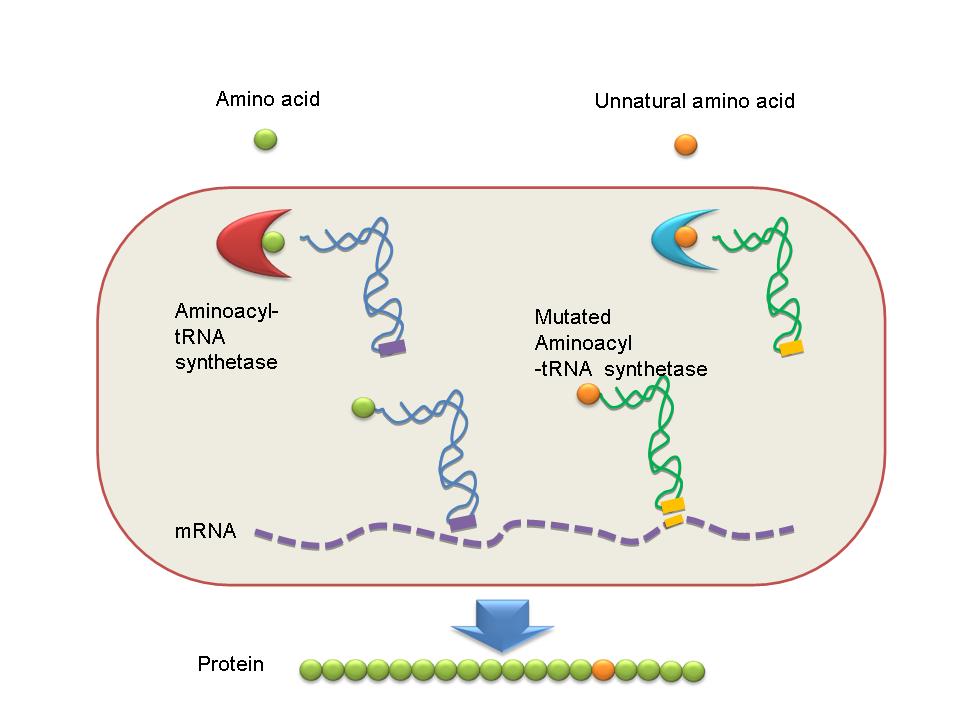From 2008.igem.org
(Difference between revisions)
|
|
| Line 1: |
Line 1: |
| | {{navigator}} | | {{navigator}} |
| - | == <font color=#3d5bb1 size=6>'''P'''</font>'''roject '''<font color=#3d5bb1 size=6>'''1'''</font>''': '''<font color=#3d5bb1 size=6>'''A'''</font>'''dding new chapters to the melody of life ''' == | + | == <font color=#3d5bb1 size=6>'''P'''</font>'''roject '''<font color=#3d5bb1 size=6>'''1'''</font>''': '''<font color=#3d5bb1 size=6>'''A'''</font>'''dding new notes to the song of life ''' == |
| | {| | | {| |
| | |- | | |- |
| | |width=50px| | | |width=50px| |
| | |width=700px| | | |width=700px| |
| - | *As we know, all of the proteins in organism are composed by natural amino acids of 20 kinds. But some researches show that, some unnatural amino acids have better effects when they are instead of relevant natural ones and are introduced into the organism. | + | *The word protein comes from the Greek word πρώτα ("prota"), meaning "of primary importance." They are the chief actors within the cell, said to be carrying out the duties specified by the information encoded in genes. If we regard life as a beautiful song, proteins, of course, are the most important strains of this song. |
| - | *In our experiment, we insert different unnatural amino acids into the mutant GFP which shows no fluorescence because its Tyr66 has been mutated to TAG(nonsense codon). When some kind of unnatural amino acids are introduced and replace TAG66, the GFP shows no more green fluorescence but some other colors. For example, blue, purple, yellow, and so on. | + | *Proteins in nature are usually composed of 20 “standard” amino acids. They are basic notes in life songs. However, as for people who are interested in synthetic biology, 20 “standard” amino acids are not enough. Could we insert some unnatural notes to write a new song apart from natural “bio-parts”? |
| - | *We believe that the introduction of unnatural amino acids into biological system has a wide and bright prospect!
| + | *In our project, we designed some new parts by which we could insert different unnatural amino acids into a certain site in target protein. Of course these unnatural amino acids would bring some new characteristics of the target protein. |
| | |[[image:cpu-project1.jpg|300px]] | | |[[image:cpu-project1.jpg|300px]] |
| | |} | | |} |
Revision as of 01:43, 1 August 2008
Project 1: Adding new notes to the song of life
|
|
- The word protein comes from the Greek word πρώτα ("prota"), meaning "of primary importance." They are the chief actors within the cell, said to be carrying out the duties specified by the information encoded in genes. If we regard life as a beautiful song, proteins, of course, are the most important strains of this song.
- Proteins in nature are usually composed of 20 “standard” amino acids. They are basic notes in life songs. However, as for people who are interested in synthetic biology, 20 “standard” amino acids are not enough. Could we insert some unnatural notes to write a new song apart from natural “bio-parts”?
- In our project, we designed some new parts by which we could insert different unnatural amino acids into a certain site in target protein. Of course these unnatural amino acids would bring some new characteristics of the target protein.
| 
|
Project 2: Customizing a biomacromolecule
|
|
- Different biomacromolecules have different bioactivities due to their different physical and chemical characters.The molecular weight of the biomacromolecule plays an essential role. If we can obtain a biomacromolecule with homogeneous molecular weight with some methods, this would dramatically increase our ability to manipulate the biomacromolecule structure and function. Our aim is to design a device which can synthesize a biomacromolecule with homogeneous molecular weight in a fixed time controlled by the concentration of the lactose. During that time, different enzymes are expressed alternatively with different operators critically modulation. Then with the catalysis of the enzyme, a biomacromolecule which has a homogeneous molecular weight is synthesized. As a result, we can further study the relationship between the structure and the function of the biomacromolecule.
| 示意图
|
Results







 "
"
